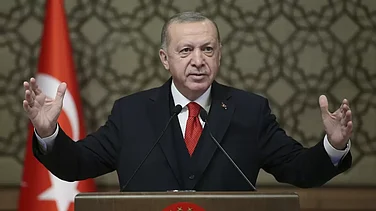Iran on Tuesday unveiled its first hypersonic missile amid rising tensions with the West. It's named Fattah, Persoan for "Conqueror".
A hypoersonic missile is one which flies at least at the speed of Mach 5. Mach 1 is the speed of sound. The Associated Press noted that the Iranian missile could travel at speed up to 15 times the speed of sound.
The development comes amid mounting tensions over the Iranian nuclear program. In March, top US general said that Iran can make a nuclear weapon in months if it decides to make it.
The new Iranian missile can bypass the US and Israeli air-defence systems, according to Iranian state-media.
What we know of the Iranian missile?
The new Iranian missile, named Fattah, has a range of 1,400 kms (870 miles), reports AP.
The AP noted that the range is about mid-range for Iran's expansive ballistic missile arsenal, which it notes the Islamic Revolutionary Guard Corps (IRGC) has built up over the years as Western sanctions largely prevent it from accessing advanced weaponry.
"Today we feel that the deterrent power has been formed. This power is an anchor of lasting security and peace for the regional countries," said Iranian President Ebrahim Raisi said at the event, as per AP.
Gen Amir Ali Hajizadeh, the head of the IRGC's aerospace programme, also said that the missile is peer-less.
"That claim, however, depends on how manoeuvrable the missile is. Ballistic missiles fly on a trajectory in which anti-missile systems like the Patriot can anticipate their path and intercept them," noted AP.
Iranian missiles and Israeli concerns
The Telegraph reported the Iranian state TV as reporting that the missile can destroy "the enemy’s advanced anti-missile systems and is a big generational leap in the field of missiles".
"It can bypass the most advanced anti-ballistic missile systems of the United States and the Zionist regime, including Israel’s Iron Dome," said the report.
The AP further noted, "Tuesday's event showed what appeared to be a moveable nozzle for the Fattah, which could allow it to change trajectories in flight. The more irregular the missile's flight path, the more difficult it becomes to intercept."
Iran is the biggest adversary of Israel in the region and supports and sponsors anti-Israel groups like the Hamas, Palestinian Islamic Jihad (PIJ), and Hezbollah. Hamas and PIJ are Palestinian terrorist groups and are committed to the destruction of Israel.
Israel also considers a nuclear-armed Iran to be an existential threat.
The Telegraph noted, "The assertion that the missile can both bypass and destroy air defence systems creates a significant security headache for Israel, Iran’s arch-foe in the region."
The Iranian regime has pitched the country against Israel since taking over it in the Islamic Revolution of 1979. Since then, anti-Israel and anti-Jewish approach has been central to the Iranian regime, notes a study by the Tony Blair Institute for Global Change.
The study noted, "Anti-Israel rhetoric featured in 66 per cent of the sample and was present in the speeches of all leaders analysed. Since 1989, Khamenei has referenced Israel more than any other theme in the analysis, with anti-Israel rhetoric featuring in 90 per cent of his sample. By contrast, anti-Israel discourse featured in 40 per cent of Khomeini’s speeches, suggesting that hostility towards Israel has become a greater ideological focal point for the regime. References to Israel as 'a cancerous tumour that must be eradicated' feature prominently in Khamenei’s speeches but also appear in those of moderate figures such as Rouhani."


























